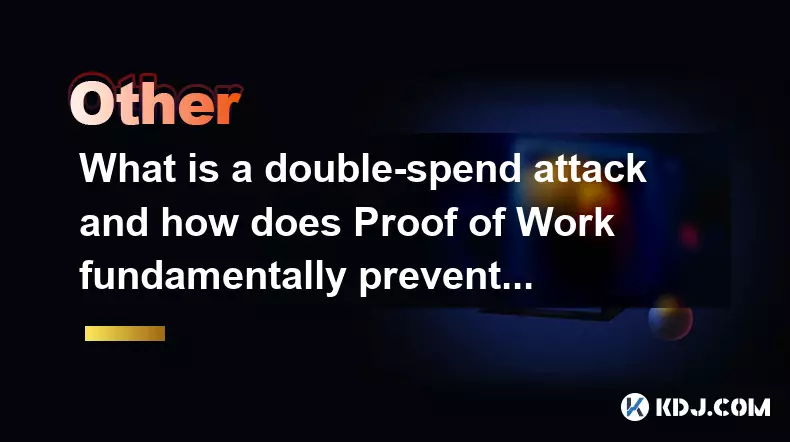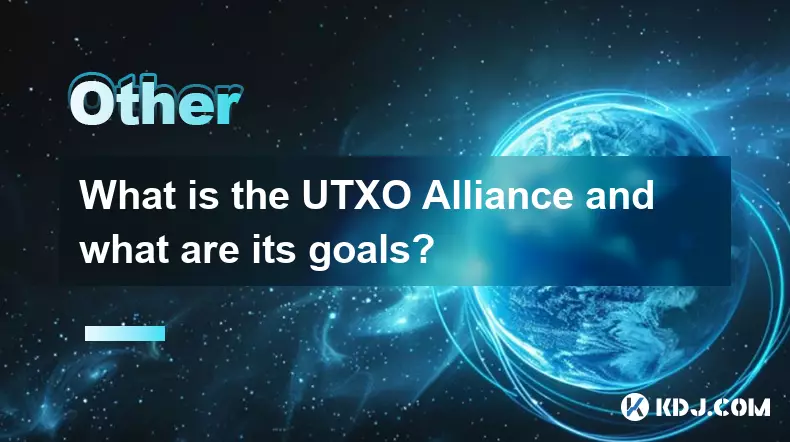-
 bitcoin
bitcoin $101752.865364 USD
-1.09% -
 ethereum
ethereum $3382.985899 USD
-1.38% -
 tether
tether $0.999658 USD
0.04% -
 xrp
xrp $2.272505 USD
-1.51% -
 bnb
bnb $989.089004 USD
0.14% -
 solana
solana $156.962612 USD
-3.08% -
 usd-coin
usd-coin $0.999776 USD
0.01% -
 tron
tron $0.290786 USD
-0.69% -
 dogecoin
dogecoin $0.174594 USD
-2.86% -
 cardano
cardano $0.560085 USD
-3.55% -
 hyperliquid
hyperliquid $40.023704 USD
-5.75% -
 chainlink
chainlink $15.324649 USD
-2.78% -
 bitcoin-cash
bitcoin-cash $493.576540 USD
-3.52% -
 zcash
zcash $571.320038 USD
-12.05% -
 stellar
stellar $0.280066 USD
-4.26%
What is a double-spend attack and how does Proof of Work fundamentally prevent it?
Proof of Work prevents double-spending by making it computationally and economically unfeasible to alter the blockchain or overwrite confirmed transactions.
Nov 08, 2025 at 08:19 pm

Understanding the Double-Spend Problem in Cryptocurrencies
1. In digital cash systems, a fundamental challenge arises when a user attempts to spend the same cryptocurrency units more than once. This is known as a double-spend attack. Unlike physical money, digital tokens can be duplicated if not properly secured, making it essential for blockchain networks to prevent such fraud.
2. A double-spend occurs when a malicious actor sends the same coins to two different recipients by broadcasting conflicting transactions. For example, a user might send 1 BTC to Alice and then quickly attempt to send that same 1 BTC to Bob, hoping one of the transactions will confirm while the other gets rejected.
3. Without a trusted central authority like a bank to validate transactions, decentralized networks must rely on consensus mechanisms to ensure transaction integrity. The risk of double-spending undermines trust in peer-to-peer digital currencies unless effectively mitigated.
4. Proof of Work (PoW) plays a critical role in eliminating this threat by requiring computational effort to add new blocks to the blockchain, thereby securing transaction history against tampering.
How Proof of Work Thwarts Double-Spending Attempts
1. In a PoW-based blockchain such as Bitcoin, miners compete to solve complex cryptographic puzzles. The first miner to find a valid solution broadcasts the new block to the network, which includes a set of verified transactions.
2. Once a transaction is included in a block and added to the chain, it gains one confirmation. Each subsequent block deepens the security, as altering any prior transaction would require redoing the work for that block and all following blocks.
3. To execute a successful double-spend, an attacker would need to create an alternative version of the blockchain where their fraudulent transaction replaces the legitimate one. This requires controlling more than 50% of the network’s total hashing power, commonly referred to as a 51% attack.
4. The immense computational cost and energy expenditure required to overpower the honest network make such attacks economically unfeasible in well-established PoW blockchains.
5. Honest nodes always follow the longest valid chain, meaning the version of the blockchain with the most accumulated proof of work. Any fork created by an attacker will be ignored by the network unless it surpasses the main chain in difficulty, which is highly improbable under normal conditions.
The Role of Transaction Confirmations in Security
1. Users and merchants are advised to wait for multiple confirmations before considering a transaction final. Each confirmation represents another block mined on top of the one containing the transaction.
2. The probability of a successful double-spend decreases exponentially with each additional confirmation. While a single confirmation may suffice for low-value transactions, high-value exchanges often require six or more.
3. Reorganizing the blockchain to reverse transactions becomes increasingly difficult as more blocks are added. An attacker attempting to rewrite history must outpace the entire network continuously, which demands unsustainable resources.
4. The deeper a transaction is embedded in the blockchain, the more immutable it becomes, thanks to the cumulative work securing each successive block.
Common Questions About Double-Spending and Proof of Work
What happens if two conflicting transactions are broadcast at nearly the same time?The network typically accepts the first-seen transaction and discards the second as invalid. Miners choose which transaction to include in their next block based on propagation speed and fee incentives. Eventually, only one version will be confirmed.
Can small PoW networks be vulnerable to double-spend attacks?Yes, smaller networks with limited hash power are more susceptible. Attackers can rent sufficient mining capacity to overpower the network temporarily, reverse recent transactions, and execute double-spends. This has occurred on lesser-known cryptocurrencies with weak mining participation.
Is Proof of Work the only way to prevent double-spending?No, other consensus mechanisms like Proof of Stake also prevent double-spending but through different means. Instead of computational work, they use economic penalties and validator staking to secure the network and enforce honest behavior.
Disclaimer:info@kdj.com
The information provided is not trading advice. kdj.com does not assume any responsibility for any investments made based on the information provided in this article. Cryptocurrencies are highly volatile and it is highly recommended that you invest with caution after thorough research!
If you believe that the content used on this website infringes your copyright, please contact us immediately (info@kdj.com) and we will delete it promptly.
- Ripple (XRP) in 2026: Hold or Fold? A Look at XRP's Future and Emerging DeFi Alternatives
- 2025-11-08 18:35:01
- Zcash ZEC Coin Price Explosion: From Privacy Niche to Center Stage
- 2025-11-08 18:55:01
- Berachain Price Prediction: Navigating the Honeycomb Hype in Crypto
- 2025-11-08 18:55:01
- Arthur Hayes, Gold, and Bitcoin: A Modern Monetary Trinity?
- 2025-11-08 19:15:01
- Shiba Inu's Next Move: Navigating a Shifting Market
- 2025-11-08 19:20:01
- Pakistan's Crypto Crossroads: Balancing Opportunity with Asset-Backed Realities
- 2025-11-08 19:20:01
Related knowledge

What are intents in crypto and how do they change user interaction?
Nov 09,2025 at 09:00am
Understanding the Role of Decentralized Exchanges in Modern Crypto Trading1. Decentralized exchanges, commonly known as DEXs, have reshaped how trader...

What is restaking and how does it enhance economic security?
Nov 09,2025 at 11:40pm
Understanding Restaking in the Blockchain Ecosystem1. Restaking refers to the process where users who have already staked their tokens in a proof-of-s...

What is a cryptographic nonce and how is it used to prevent replay attacks?
Nov 08,2025 at 05:00pm
Understanding Cryptographic Nonces in Blockchain Systems1. A cryptographic nonce is a number used only once within a specific cryptographic communicat...

What are the trade-offs between liveness and safety in a consensus protocol?
Nov 09,2025 at 12:20pm
Understanding the Role of Liquidity Pools in Decentralized Finance1. Liquidity pools are foundational components within decentralized exchanges (DEXs)...

What is a call data in an Ethereum transaction and how is it used?
Nov 09,2025 at 01:59am
Understanding Call Data in Ethereum Transactions1. Call data refers to the information sent along with a transaction on the Ethereum network that spec...

What is the UTXO Alliance and what are its goals?
Nov 09,2025 at 01:39pm
Understanding the UTXO Alliance1. The UTXO Alliance is a collaborative initiative formed by prominent blockchain projects and developers who support t...

What are intents in crypto and how do they change user interaction?
Nov 09,2025 at 09:00am
Understanding the Role of Decentralized Exchanges in Modern Crypto Trading1. Decentralized exchanges, commonly known as DEXs, have reshaped how trader...

What is restaking and how does it enhance economic security?
Nov 09,2025 at 11:40pm
Understanding Restaking in the Blockchain Ecosystem1. Restaking refers to the process where users who have already staked their tokens in a proof-of-s...

What is a cryptographic nonce and how is it used to prevent replay attacks?
Nov 08,2025 at 05:00pm
Understanding Cryptographic Nonces in Blockchain Systems1. A cryptographic nonce is a number used only once within a specific cryptographic communicat...

What are the trade-offs between liveness and safety in a consensus protocol?
Nov 09,2025 at 12:20pm
Understanding the Role of Liquidity Pools in Decentralized Finance1. Liquidity pools are foundational components within decentralized exchanges (DEXs)...

What is a call data in an Ethereum transaction and how is it used?
Nov 09,2025 at 01:59am
Understanding Call Data in Ethereum Transactions1. Call data refers to the information sent along with a transaction on the Ethereum network that spec...

What is the UTXO Alliance and what are its goals?
Nov 09,2025 at 01:39pm
Understanding the UTXO Alliance1. The UTXO Alliance is a collaborative initiative formed by prominent blockchain projects and developers who support t...
See all articles





















![The Graph Price Prediction [GRT Crypto Price News Today] The Graph Price Prediction [GRT Crypto Price News Today]](/uploads/2025/11/07/cryptocurrencies-news/videos/690d4df44fe69_image_500_375.webp)




















































